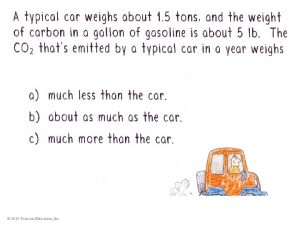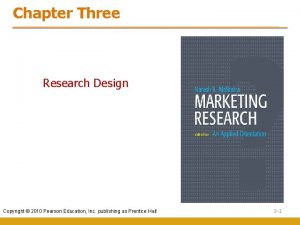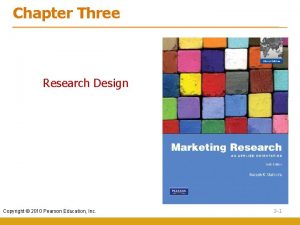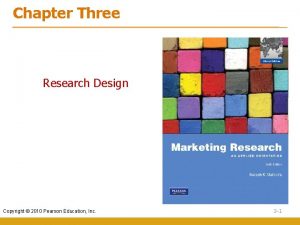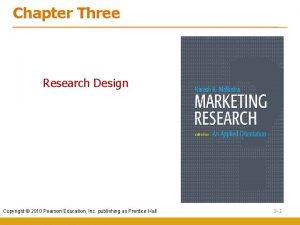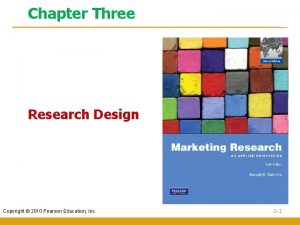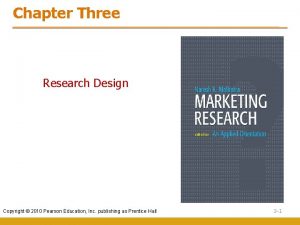Chapter Three Research Design Copyright 2010 Pearson Education
































- Slides: 32

Chapter Three Research Design Copyright © 2010 Pearson Education, Inc. 3 -1

Chapter Outline 1) Research Design: Definition and components 2) Research Design: Classification 3) Alternative Research Design: Relationships Among Exploratory, Descriptive and Causal Research 4) Potential Sources of Error in research design 5) Marketing Research Proposal 6) Online Research 7) Summary 8) Case of Citicorp Banks Copyright © 2010 Pearson Education, Inc. 3 -2

Marketing Research Process Step 1: Defining the Problem Step 2: Developing an Approach to the Problem Step 3: Formulating a Research Design Step 4: Doing Field Work or Collecting Data Step 5: Preparing and Analyzing Data Step 6: Preparing and Presenting the Report Copyright © 2010 Pearson Education, Inc. 3 -3

Research Design: Definition • Research design (step 3) formulated after the problem has been defined (step 1) and the approach developed (step 2). • A research design is a framework or blueprint (plan) for conducting the marketing research project. It details the procedures necessary for obtaining the information needed to structure or solve marketing research problems. Copyright © 2010 Pearson Education, Inc. 3 -4

Components of a Research Design • Design the exploratory, descriptive, and/or causal phases of the research (Chapters 3 - 7) • Specify the measurement and scaling procedures (Chapters 8 and 9) • Construct and pretest a questionnaire (interviewing form) or an appropriate form for data collection (Chapter 10) • Specify the sampling process and sample size (Chapters 11 and 12) • Develop a plan of data analysis (Chapter 14) Copyright © 2010 Pearson Education, Inc. 3 -5

A Classification of Marketing Research Designs Research Design Conclusive Research Design Exploratory Research Design Descriptive Research Cross-Sectional Design Single Cross. Sectional Design Copyright © 2010 Pearson Education, Inc. Causal Research Longitudinal Design Multiple Cross. Sectional Design 3 -6

Exploratory & Conclusive Research Differences Exploratory Conclusive Objective: To provide insights and understanding To test specific hypotheses and examine relationships Characteristics: Information needed is defined Information needed is clearly only loosely. Research process is defined. Research process is formal flexible and unstructured. and structured. Sample is large and Sample is small and nonrepresentative. Data analysis is representative. Analysis of quantitative primary data is qualitative. Findings/ Results: Tentative (unsure, uncertain) Conclusive Outcome: Generally followed by further exploratory or conclusive research Findings used as input into decision making Copyright © 2010 Pearson Education, Inc. 3 -7

A Comparison of Basic Research Designs Exploratory Descriptive Causal Objective: Discovery of ideas and insights Describe market characteristics or functions Determine cause and effect relationships Characteristics: Flexible, versatile Marked by the prior formulation of specific hypotheses Often the front end of total research design Preplanned and structured design Manipulation of independent variables, measure the effect on dependent variables, Control mediating variables Expert surveys Pilot surveys Case studies Secondary data: qualitative analysis qualitative research Secondary data: quantitative analysis Surveys Panels Observation and other data Methods: Copyright © 2010 Pearson Education, Inc. Experiments 3 -8

Uses of Exploratory Research • Formulate a problem or define a problem more precisely • Identify alternative courses of action • Develop hypotheses • Isolate key variables and relationships for further examination • Gain insights for developing an approach to the problem • Establish priorities for further research Copyright © 2010 Pearson Education, Inc. 3 -9

Uses of Descriptive Research • To describe the characteristics of relevant groups, such as consumers, salespeople, organizations, or market areas • To estimate the percentage of units in a specified population exhibiting a certain behavior • To determine the perceptions of product characteristics • To determine the degree to which marketing variables are associated • To make specific predictions Copyright © 2010 Pearson Education, Inc. 3 -10

Descriptive research design: Cross-Sectional Designs • Involve the collection of information from any given sample of population elements only once • In single cross-sectional designs, there is only one sample of respondents drawn of the target population, and information is obtained from this sample only once. • In multiple cross-sectional designs, there are two or more samples of respondents, and information from each sample is obtained only once. Often, information from different samples is obtained at different times. A type of special interest analysis of this design is Cohort Analysis. • Cohort analysis consists of a series of surveys conducted at appropriate time intervals, where the cohort serves as the basic unit of analysis. Copyright © 2010 Pearson Education, Inc. 3 -11

Consumption of Various Soft Drinks by Various Age Cohorts Table 3. 3 Percentage consuming on a typical day Age 1950 1969 1979 8 -19 20 -29 30 -39 40 -49 50+ 52. 9 45. 2 33. 9 23. 2 18. 1 62. 6 60. 7 46. 6 40. 8 28. 8 73. 2 76. 0 67. 7 58. 6 50. 0 81. 0 75. 8 71. 4 67. 8 51. 9 C 1: C 2: C 3: C 4: cohort born prior to 1900 1901 -10 1911 -20 1921 -30 Copyright © 2010 Pearson Education, Inc. C 2 C 5: C 6: C 7: C 8: C 3 cohort born C 8 C 7 C 6 C 5 C 4 1931 -40 1940 -49 1950 -59 1960 -69 3 -12

Descriptive Research Design Longitudinal Designs • A fixed sample (or samples) of population elements is measured repeatedly on the same variables. (the same people are studied over time and the same variables are measured). • A longitudinal design differs from a crosssectional design in that the sample or samples participants remain the same over time. • Longitudinal design study provides changes that take place over time. Copyright © 2010 Pearson Education, Inc. 3 -13

Multiple Cross-Sectional vs. Longitudinal Multi Cross - Sectional Design Longitudinal Design Sample Surveyed at T 1 Different Sample Surveyed at T 2 Sample Surveyed at T 1 Same Sample also Surveyed at T 2 Time Copyright © 2010 Pearson Education, Inc. T 1 T 2 3 -14

Relative Advantages and Disadvantages of Longitudinal and Cross-Sectional Designs Table 3. 4 Evaluation Criteria Detecting Change Large amount of data collection Accuracy Representative Sampling Response bias Cross-Sectional Longitudinal Design + + + - Note: A “+” indicates a relative advantage over the other design, whereas a “-” indicates a relative disadvantage. Copyright © 2010 Pearson Education, Inc. 3 -15

Cross-Sectional Data May Not Show Change Table 3. 5 Brand Purchased Brand A Brand B Brand C Total Copyright © 2010 Pearson Education, Inc. Time Period 1 Survey Period 2 Survey 200 300 500 1000 3 -16

Longitudinal Data May Show Substantial Change Brand Purchased in Period 1 Brand A 200 Brand B 300 Brand C 500 Total 1000 Brand Purchased in Period 2 Brand A Brand B Brand C Total 100 25 75 200 50 100 150 300 50 175 275 500 200 300 500 1000 Copyright © 2010 Pearson Education, Inc. 3 -17

Uses of Causal Research • To understand which variables are the cause (independent variables) and which variables are the effect (dependent variables) of a phenomenon. • To determine the nature of the relationship between the causal variables and the effect to be predicted. Copyright © 2010 Pearson Education, Inc. 3 -18

Alternative Research Designs (a) Exploratory Research • Secondary Data Analysis • Focus Groups (b) Conclusive Research • Descriptive/Causal (c) Conclusive Research • Descriptive/Causal Copyright © 2010 Pearson Education, Inc. Conclusive Research • Descriptive/Causal Exploratory Research • Secondary Data Analysis • Focus Groups 3 -19

Potential Sources of Error in Research Designs Total Error Non-sampling Error Random Sampling Error Response Error Researcher Error Surrogate Information Error Measurement Error Population Definition Error Sampling Frame Error Data Analysis Error Copyright © 2010 Pearson Education, Inc. Interviewer Error Respondent Selection Error Questioning Error Recording Error Cheating Error Non-response Error Respondent Error Inability Error Unwillingness Error 3 -20

Marketing Research Proposal • Executive Summary • Background • Problem Definition/Objectives of the Research • Approach to the Problem • Research Design • Fieldwork/Data Collection • Data Analysis • Reporting • Cost and Time • Appendices Copyright © 2010 Pearson Education, Inc. 3 -21

Copyright © 2010 Pearson Education, Inc. 3 -22

Example: Research design The case of Citicorp Banks Copyright © 2010 Pearson Education, Inc. 3 -23

Citicorp Banks on Exploratory, Descriptive, and Causal Research - Marketing Research at Citicorp is typical in that it is used to measure consumer awareness of products, monitor their satisfaction and attitudes associated with the product, track product usage and diagnose problems as they occur. - To accomplish these tasks Citicorp makes extensive use of exploratory, descriptive, and causal research. Often it is advantageous to offer special financial packages to specific groups of customers. In this case, a financial package is being designed for senior citizens. The following seven-step process was taken by marketing research to help in the design: Copyright © 2010 Pearson Education, Inc. 3 -24

Citicorp Banks on Exploratory, Descriptive, and Causal Research 1) A taskforce was created to better define the market parameters to include all the needs of the many Citicorp branches. A final decision was made to include Americans 55 years of age or older. Copyright © 2010 Pearson Education, Inc. 3 -25

Citicorp Banks on Exploratory, Descriptive, and Causal Research 2) Exploratory research in the form of secondary data analysis of the mature or older market was then performed and a study of competitive products was conducted. Exploratory qualitative research involving focus groups was also carried out in order to determine the needs and desires of the market and the level of satisfaction with the current products. In the case of senior citizens, a great deal of diversity was found in the market. This was determined to be due to such factors as affluence, relative age, and the absence or presence of a spouse. Copyright © 2010 Pearson Education, Inc. 3 -26

Citicorp Banks on Exploratory, Descriptive, and Causal Research 3) The next stage of research was brainstorming. This involved the formation of many different financial packages aimed at the target market. In this case, a total of 10 ideas were generated. Copyright © 2010 Pearson Education, Inc. 3 -27

Citicorp Banks on Exploratory, Descriptive, and Causal Research 4) The feasibility of the 10 ideas generated in step 3 was then tested. The ideas were tested on the basis of whether they were possible in relation to the business. The following list of questions was used as a series of hurdles that the ideas had to pass to continue on to the next step. • Can the idea be explained in a manner that the target market will easily understand? • Does the idea fit into the overall strategy of Citicorp? Copyright © 2010 Pearson Education, Inc. 3 -28

Citicorp Banks on Exploratory, Descriptive, and Causal Research § Is there an available description of a specific target market for the proposed product? § Does the research conducted so far indicate a potential match for target market needs, and is the idea perceived to have appeal to this market? § Is there a feasible outline of the tactics and strategies for implementing the program? § Have the financial impact and cost of the program been thoroughly evaluated and determined to be in line with company practices? In this study, only one idea generated from the brainstorming session made it passed all the listed hurdles to step 5. Copyright © 2010 Pearson Education, Inc. 3 -29

Citicorp Banks on Exploratory, Descriptive, and Causal Research 5) A creative work-plan was then generated. This plan was to emphasize the competitive advantage of the proposed product as well as better delineate (describe) the specific features of the product. 6) The previous exploratory research was now followed up with descriptive research in the form of mall intercept surveys of people in the target market range. The survey showed that the list of special features was too long and it was decided to drop the features more commonly offered by competitors. Copyright © 2010 Pearson Education, Inc. 3 -30

Citicorp Banks on Exploratory, Descriptive, and Causal Research 7) Finally, the product was test marketed in six of the Citicorp branches within the target market. Test marketing is a form of causal research. Given successful test marketing results, the product is introduced nationally. Copyright © 2010 Pearson Education, Inc. 3 -31

Questions for Revision 1. discuss three differences between exploratory research and conclusive research (slide 7) 2. Compare between multi-cross sectional and longitudinal designs in: a. detecting change and b. survey samples and sampling representation. (slide 14 -15) 3. What is the relationship among exploratory, descriptive, and causal research. (slide 19) 4. What potential sources of non-sampling errors can affect a research design. (slide 20) 5. List the major components of the research design. (slide 22) Copyright © 2010 Pearson Education, Inc. 3 -32
 2010 pearson education inc
2010 pearson education inc Copyright 2010 pearson education inc
Copyright 2010 pearson education inc Copyright 2010 pearson education inc
Copyright 2010 pearson education inc Copyright 2010 pearson education inc
Copyright 2010 pearson education inc Copyright 2010 pearson education inc
Copyright 2010 pearson education inc Copyright 2010 pearson education inc
Copyright 2010 pearson education inc 2010 pearson education inc
2010 pearson education inc Copyright 2010 pearson education inc
Copyright 2010 pearson education inc Composition copyright example
Composition copyright example Copyright 2010 pearson education inc
Copyright 2010 pearson education inc Pearson education limited 2017
Pearson education limited 2017 Copyright by pearson education inc. answers
Copyright by pearson education inc. answers 2009 pearson education inc
2009 pearson education inc 2018 pearson education inc
2018 pearson education inc 2014 pearson education inc
2014 pearson education inc Copyright by pearson education inc. answers
Copyright by pearson education inc. answers Copyright 2003 pearson education inc
Copyright 2003 pearson education inc Copyright 2009 pearson education inc
Copyright 2009 pearson education inc 2015 pearson education inc
2015 pearson education inc Copyright 2009 pearson education inc
Copyright 2009 pearson education inc 2009 pearson education inc
2009 pearson education inc Copyright 2009 pearson education inc
Copyright 2009 pearson education inc 2009 pearson education inc
2009 pearson education inc Copyright pearson education inc
Copyright pearson education inc 2010 pearson education inc
2010 pearson education inc 2010 pearson education inc answers
2010 pearson education inc answers 2010 pearson education inc answers
2010 pearson education inc answers 2010 pearson education inc answers
2010 pearson education inc answers 2010 pearson education inc answers
2010 pearson education inc answers 2010 pearson education inc
2010 pearson education inc 2010 pearson education inc
2010 pearson education inc 2010 pearson education inc
2010 pearson education inc The four forces shown have the same strength
The four forces shown have the same strength


























